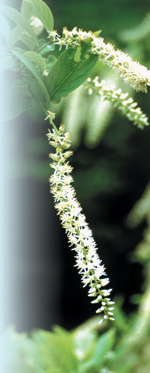Sweetspire, a Great North Carolina Native
go.ncsu.edu/readext?236328
en Español / em Português
El inglés es el idioma de control de esta página. En la medida en que haya algún conflicto entre la traducción al inglés y la traducción, el inglés prevalece.
Al hacer clic en el enlace de traducción se activa un servicio de traducción gratuito para convertir la página al español. Al igual que con cualquier traducción por Internet, la conversión no es sensible al contexto y puede que no traduzca el texto en su significado original. NC State Extension no garantiza la exactitud del texto traducido. Por favor, tenga en cuenta que algunas aplicaciones y/o servicios pueden no funcionar como se espera cuando se traducen.
Português
Inglês é o idioma de controle desta página. Na medida que haja algum conflito entre o texto original em Inglês e a tradução, o Inglês prevalece.
Ao clicar no link de tradução, um serviço gratuito de tradução será ativado para converter a página para o Português. Como em qualquer tradução pela internet, a conversão não é sensivel ao contexto e pode não ocorrer a tradução para o significado orginal. O serviço de Extensão da Carolina do Norte (NC State Extension) não garante a exatidão do texto traduzido. Por favor, observe que algumas funções ou serviços podem não funcionar como esperado após a tradução.
English
English is the controlling language of this page. To the extent there is any conflict between the English text and the translation, English controls.
Clicking on the translation link activates a free translation service to convert the page to Spanish. As with any Internet translation, the conversion is not context-sensitive and may not translate the text to its original meaning. NC State Extension does not guarantee the accuracy of the translated text. Please note that some applications and/or services may not function as expected when translated.
Collapse ▲
Virginia Sweetspire
Photo by Todd Lasseigne
Virginia sweetspire, Itea virginica, has the characteristics we all look for when we hear the word “native.” Easy to establish, sweetspire is insect and disease resistant and drought tolerant. It has great leaf and flower color and works well in the naturalized sections of the urban landscape. This deciduous shrub is considered homegrown, not just in North Carolina but from the pine barrens of New Jersey to the Florida wetlands and west to Missouri.
Sweetspire produces white, fragrant flowers in May or June on racemes from 3- to 6-inches long. It flowers on the previous season’s wood, so prune immediately after the blooms fade. Fall color is superb when the green foliage, which is oblong and slightly serrated, turns to hues of yellow, orange, crimson and purple and remains on the plant until December. One drawback is its tendency to spread. A mature plant might only be 3 to 5 feet in height but will spread up to 10 feet in width. This tendency to take up space makes this a perfect choice for mass plantings in tough locations such as slopes or hillsides where we would frequently use junipers. Sweetspire can handle plenty of sun but will develop a thinner canopy in light shade. Though this plant tolerates dry sites, it prefers moist, fertile soil.

Virginia Sweetspire
Photo by Todd Lasseigne
Look for some of the nursery selections such as ‘Henry’s Garnet’ and ‘Little Henry’ that have a more restrained growing pattern. These selections will have the characteristics noted above but the spread will be limited to 1 1/2 times the height of the specimen. Both can be seen at the JC Raulston Arboretum (JCRA) at NC State University. If you would like to compare additional but perhaps less common sweetspire cultivars, the JCRA also retains ‘Longspire’, ‘Merlot’ and ‘Shirley’s Compact’ within its collections. The JCRA is located at 4301 Beryl Road in Raleigh; Web address is jcra.ncsu.edu.
Carl Matyac


